- About
-
Research
- Agronomy and farming systems
-
Agricultural crop research
-
Research projects - agriculture
- About SASSA-SAI
- BioBoost
- Biomass Connect
- CTP for Sustainable Agricultural Innovation
- Climate Ready Beans - workshop presentations (March 2022)
- Crop diversity HPC cluster
- Designing Future Wheat
- Final project workshop
- Get involved
- List of materials
- News and updates
- Partners
- Rustwatch
- The Sentinel Crop Disease Surveillance Network
- The research team
- UK Cereal Pathogen Virulence Survey
- UK wheat varieties pedigree
- Weed management - IWM Praise
- Crop breeding
- Crop characterisation
- Data sciences
- Genetics and pre-breeding
- Plant biotechnology
- Plant pathology and entomology
- Resources
-
Research projects - agriculture
-
Horticultural crop research
-
Research projects - horticulture
- Augmented Berry Vision
- BEESPOKE
- Boosting brassica nutrition in smart growing systems
- CTP for Fruit Crop Research
- Develop user-friendly nutrient demand models
- Egg laying deterrents for spotted wing drosophila
- Enhancing the nutritional quality of tomatoes
- Improving berry harvest forecasts and productivity
- Improving vineyard soil health through groundcover management
- Intelligent growing systems
- Knowledge transfer for sustainable water use
- POME: Precision Orchard Management for Environment
- RASCAL
- STOP-SPOT
- UV-Robot
- Crop science and production systems
- Genetics, genomics and breeding
- Pest and pathogen ecology
- Field vegetables and salad crops
- Plum Demonstration Centre
- The WET Centre
- Viticulture and Oenology
-
Research projects - horticulture
- Crop Science Centre
- Research Projects
- Research Publications
-
Services
- Analytical Services
- Business Development
- Commercial trial services
- Membership
- Plant breeding
- Plant characterisation
- Seed certification
-
Training
-
Technical agronomy training
- Advanced crop management of bulb onions
- Advanced crop management of vegetable brassicas
- Advanced nutrient management for combinable crops
- Benefits of cover crops in arable systems
- Best practice agronomy for cereals and oilseed rape
- Developing a Successful Strategy for Spring Crops
- Disease Management and Control in Cereal Crops
- Incorporating SFI options into your rotation
- Protected Environment Horticulture – Best Practice
- Techniques for better pest management in combinable crops
- Crop inspector and seed certification
- Licensed seed sampling
-
Technical agronomy training
- News & Views
- Events
-
Knowledge Hub
- Alternative and break crops
-
Crop genetics
- POSTER: Diversity enriched wheat (2025)
- POSTER: Genetics of wheat flag leaf size (2024)
- POSTER: Wheat yield stability (2024)
- Poster: Traits for future cereal crops (2022)
- POSTER: wild wheat fragment lines (2022)
- POSTER: Improving phenotyping in crop research (2022)
- PRESENTATION: Plant breeding for regen ag
- Poster: Designing Future Wheat (2020)
- Crop nutrition
-
Crop protection
- POSTER: Understanding the hierarchy of black-grass control (2025)
- POSTER: Emerging weed threats (2025)
- POSTER: Disease control in barley (2025)
- Poster: Weed seed predation in regen-ag (2024)
- POSTER: Disease control in winter wheat (2025)
- POSTER: Mode of action (2023)
- POSTER: Inter-row cultivation for black-grass control (2022)
- POSTER: UKCPVS winter wheat yellow rust in spring 2025 (2025)
- Poster: Management of Italian ryegrass (2021)
- POSTER: UKCPVS winter wheat rusts - 2024/25 review (2025)
- POSTER: UKCPVS disease monitoring and the benefit to UK growers (2025)
- POSTER: Diagnosing and scoring crop disease using AI (2025)
- POSTER: Finding new sources of Septoria resistance (2024)
- POSTER: Fungicide resistance research (2024)
- POSTER: Detecting air-borne pathogens (2024)
- POSTER: Oilseed rape diseases (2024)
- POSTER: Fungicide resistance research (2024)
- POSTER: Improving chocolate spot resistance (2022)
- Poster: Pathogen diagnostics (2022)
- Fruit
- Regen-ag & sustainability
-
Seed certification
- POSTER: Wheat DUS (2024)
- POSTER: Innovation in variety testing (2024)
- POSTER: AI and molecular markers for soft fruit (2024)
- POSTER: Barley crop identification (2023)
- POSTER: Herbage grass crop identification (2023)
- POSTER: Herbage legume crop identification (2024)
- POSTER: Minor cereal crop inspecting (2023)
- POSTER: Pulse crop identification (2023)
- POSTER: Wheat crop identification (2023)
-
Soils and farming systems
- POSTER: Checking soil health - across space and time (2024)
- POSTER: Checking soil health - step by step (2024)
- POSTERS: Changing soil management practices (2022)
- Poster: Monitoring natural enemies & pollinators (2021)
- POSTER: Soil structure and organic matter (2024)
- POSTER: Novel wheat genotypes for regen-ag (2024)
- Video: New Farming Systems project (2021)
- Video: Saxmundham Experimental Site (2021)
- POSTER: Impact of prolonged rainfall on soil structure (2024)
- POSTER: Soil & agronomic monitoring study (2024)
- POSTER: The impact of rotations & cultivations (2024)
- VIDEO: Great Soils; soil sampling guidelines (2020)
- Poster: Soil invertebrates within arable rotations (2024)
- VIDEO: Soil health assessment (2021)
- POSTER: Saxmundham - modern P management learnings
- POSTER: Saxmundham - 125 years of phosphorus management
- Poster: Soil phosphorus - availability, uptake and management (2025)
- POSTER: Morley long term experiments (2025)
- POSTER: Exploiting novel wheat genotypes for regen-ag (2025)
- Video: Saxmundham Experimental Site (2021)
- Varieties
Disorders of the skin
Skin disorders that occur naturally during storage
Superficial scald

Superficial scald
- Patches of skin turn bronze or brown and become slightly sunken. In the early stages of development un-degraded green skin is interspersed with affected skin.
- The incidence and severity of the disorder increases with duration of storage and may develop rapidly when fruit is brought to ambient temperatures.
- Of the apple varieties currently grown in the UK Bramley’s Seedling is the most scald susceptible.
- The ethylene antagonist SmartFreshTM provides effective control of superficial scald.
- Alternative methods of control include scrubbed low oxygen or low ethylene storage.
- In AHDB Horticulture Project TF 191, the use of SmartFreshTM or ethylene scrubbing were both found to reduce the incidence of scald in long-term CA stored Bramley’s Seedling.
- Where scald is detected during store monitoring the affected consignments should be marketed immediately.
- Scald susceptibility is influenced markedly by climatic conditions during fruit development and is aggravated by early harvesting.
- Dynamic controlled storage employing low oxygen regimes (0.4-0.8% O2, 5% CO2 at 4.5-5.0 oC) can extend the period of scald free storage beyond the existing 6 month window imparted by 5% CO2, 1% O2. Different technologies exist to implement DCA storage and growers and store operators must follow manufacturers protocols to ensure fruits do not suffer from anaerobic conditions that will lead to fruit damage and off-flavours.
Senescent scald
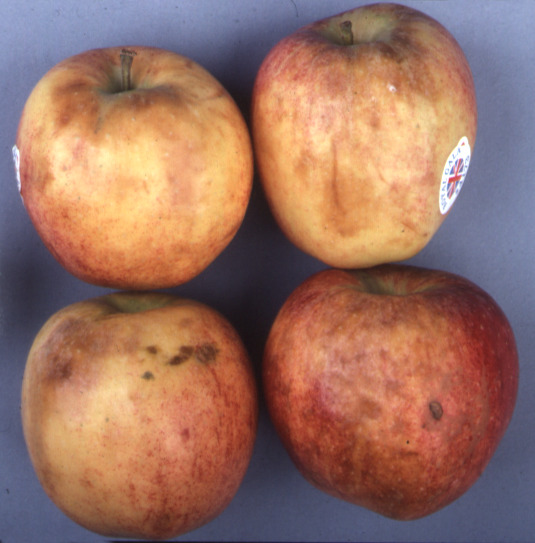
Senescent scald
- As the name implies there are certain varieties of apple that develop a browning of the skin when the fruit is over-stored.
- Generally this type of scald should not be a problem where storage recommendations are adhered to.
- Gala is susceptible to senescent scald late in the storage period.
- The problem is aggravated by late harvesting, poor control of storage conditions, over-storage and delayed marketing.
- Susceptible varieties (Fiesta (Red Pippin), Gala and Jonagold) required for long storage should be stored in CA conditions with a relatively high carbon dioxide content.
Lenticel blotch pit
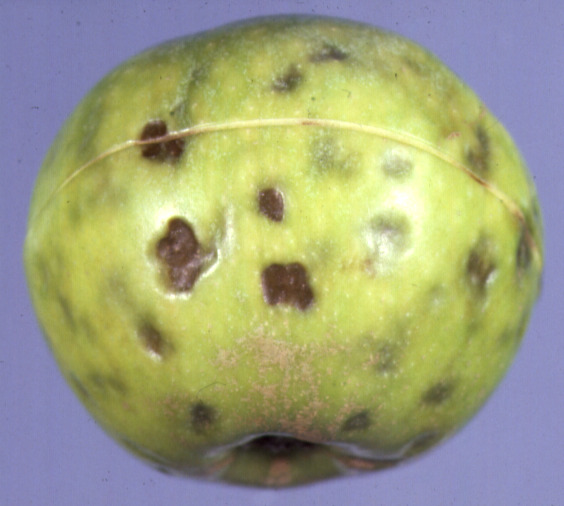
Lenticel blotch pit (Cox)
- Lenticel blotch pit is a disorder that is related closely to bitter pit.
- Brown lesions form in each ‘pit’ beginning at a lenticel.
- Bramley, Cox and Egremont Russet apples are particularly prone to the disorder that occurs in fruit with abnormally low levels of calcium.
- Consignments of Cox apples containing more than 3.8 mg 100g-1 fresh weight of calcium are unlikely to develop lenticel blotch pit.
- Fruit analysis should be used to determine risk.
- Control measures are the same as those described for bitter pit.
Skin necrosis in Gala apples
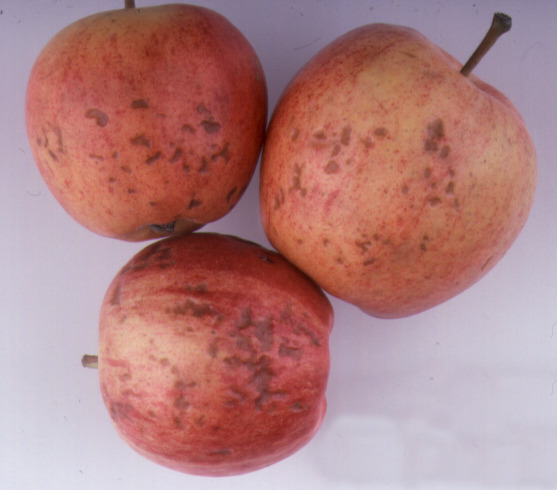
Skin necrosis on Gala
- A skin disorder has been observed on Gala apples stored under commercial conditions in the UK.
- The problem occurs rarely and has only been observed on fruit that has been harvested very late and kept in air storage.
- The problem has not been apparent on CA-stored fruit or in air-stored fruit picked at the correct stage of maturity and held at the recommended storage temperature for the prescribed period.
- Mineral composition of affected and non-affected apples was similar.
- Provided that growers adhere to guidelines provided on harvest dates and storage recommendations this disorder should not be a problem in commercial consignments of Gala.
Skin disorders that are induced by CA conditions
External carbon dioxide injury
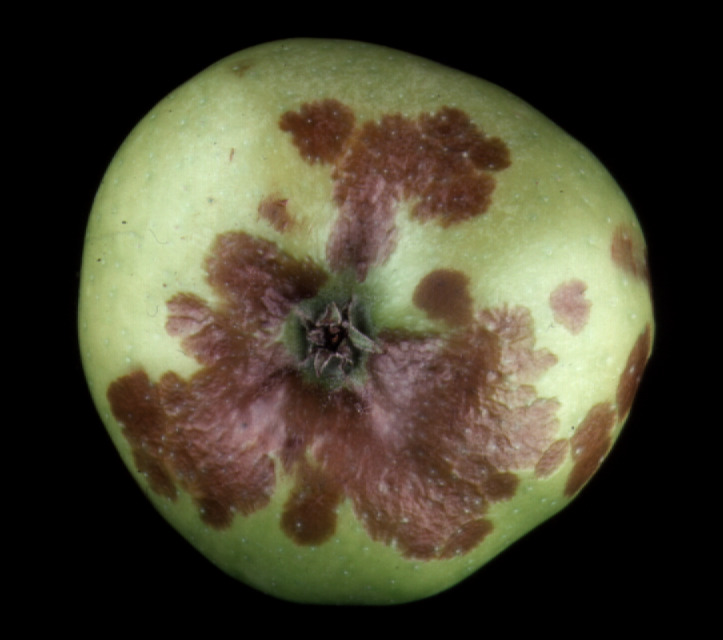
External carbon dioxide injury (Bramley)
- This form of damage never occurs in air-stored apples and is not common in apples stored under CA conditions in the UK.
- Generally carbon dioxide injury occurs where fruit is kept in atmospheres containing carbon dioxide at higher than recommended concentrations.
- In the early stages of development damage symptoms may be confused with those of superficial scald.
- However, lesions caused by excessive carbon dioxide are more sharply defined than those described for scald.
- Moreover, external carbon dioxide injury occurs within the first few weeks of storage and does not progress thereafter.
- In contrast, superficial scald usually develops after several months and becomes progressively worse with time in store.
- Bramley’s Seedling apples are susceptible to external carbon dioxide injury under recommended CA conditions.
- Where SmartFreshTM is applied to Bramley, the delay before establishing CA conditions must be extended for 21 days. During this initial three week period after Bramleys have been cooled, an alterantive regime establishment protocol has been tested whereby O2 levels are allowed to drop by fruit respiration to 10%, keeping CO2 scrubbed to <1% CO2. After the 21 day period has passed, CO2 is allowed to rise to 5% while O2 drops via respiration.
- Empire, a variety not widely grown in the UK, is highly susceptible to external carbon dioxide injury particularly when treated with SmartFreshTM.
Low oxygen injury
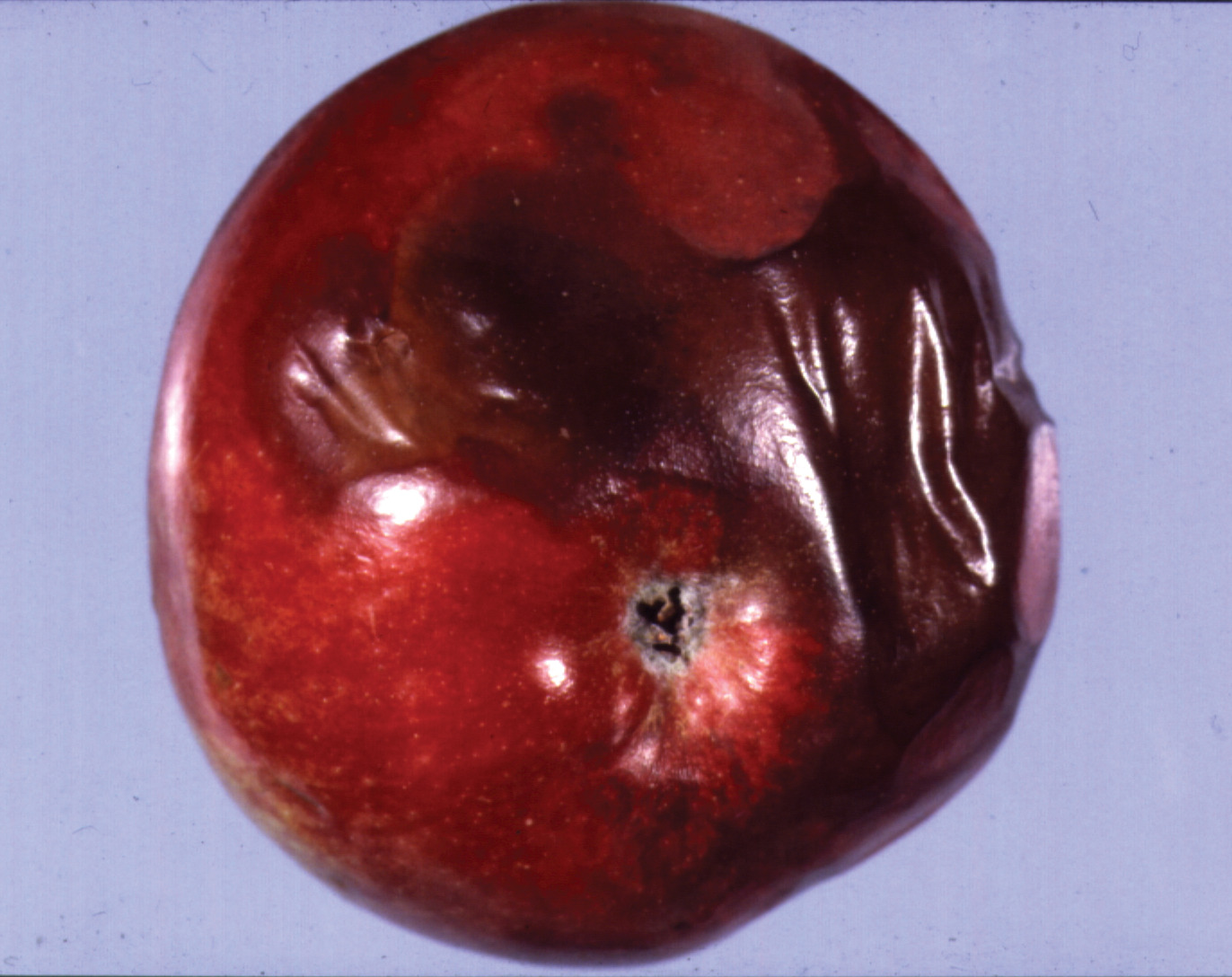
Low oxygen injury (McIntosh)
- Injuries to the skin of apples due to low-oxygen storage are generally not recognised on apples grown in the UK.
- In other growing regions low-oxygen injury is expressed in the form of darkening of the red and green regions of the skin.
- Ribbon scald may also be induced in some varieties by low-oxygen atmospheres. McIntosh is considered the most sensitive to this type of injury.
- The risk of low-oxygen injury is minimised by picking at the correct stage of maturity, establishing storage conditions promptly and maintaining CA conditions within prescribed limits.
Skin disorders that are induced by chemicals
Calcium spray injury
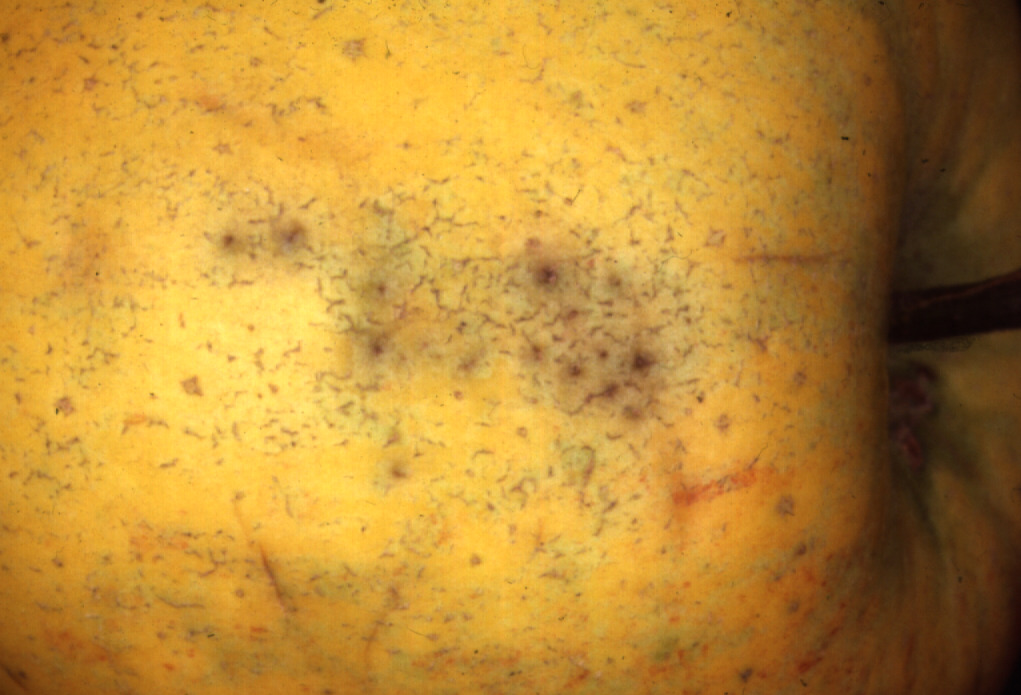 |
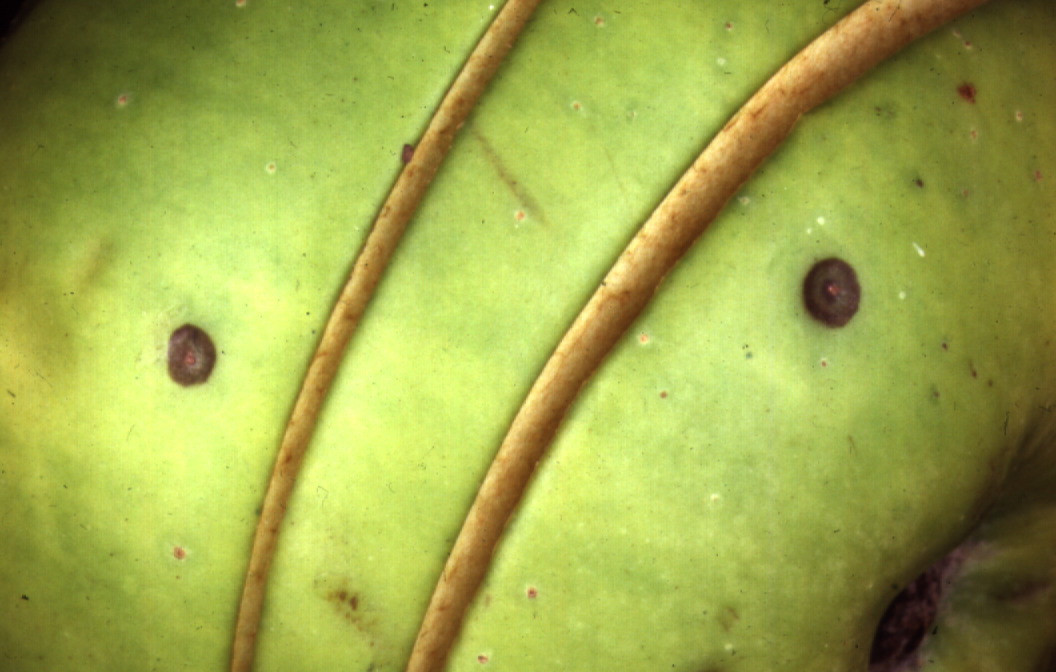 |
| Post-harvest calcium chloride damage (Cox) | Post-harvest calcium chloride damage (Bramley) |
Pre-harvest calcium applications
- The concentration of calcium in apple fruits can be increased by pre-harvest calcium sprays.
- Raising the calcium concentration in fruits reduces susceptibility of apples to calcium-dependent disorders such as bitter pit and senescent breakdown.
- However, pre-harvest sprays containing calcium may cause lenticel injury to the fruit. Early sprays of calcium can result in distortion of the fruit of sensitive cultivars.
- Higher application rates result in greater uptake of calcium but there is a corresponding increase in the risk of injury to the fruit.
- The injury is usually centred on lenticels although in severe cases entire areas of skin may be affected.
- The areas around the lenticels become brown or black and may become sunken.
- There may be localised greening of the skin related to the localised uptake of calcium.
- There is marked varietal variation in susceptibility to calcium injury.
- It is important therefore to treat only those cultivars advised by the manufacturers and to apply materials in strict accordance with label instructions.





